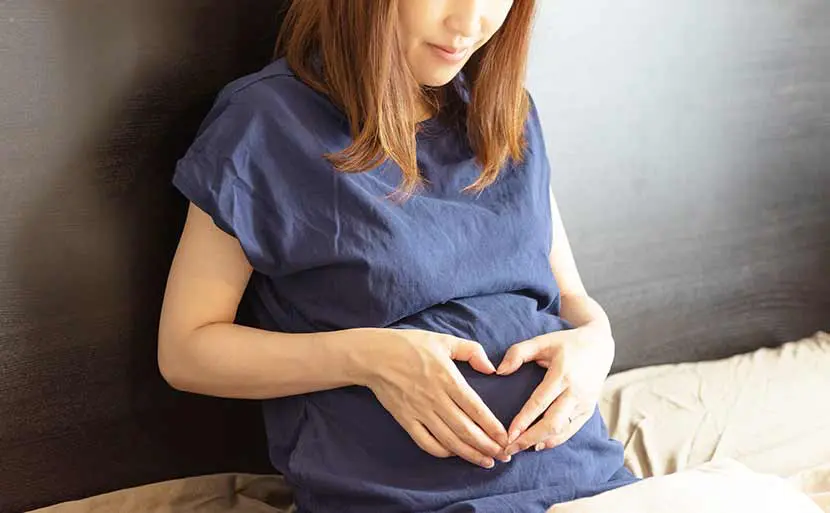Summary of this article
The mid-term pregnancy is the period from 14 weeks 0 days to 27 weeks 6 days. The placenta, which plays an important role in the development of the baby inside the abdomen, is completed and physical symptoms such as morning sickness gradually subside. Physical changes include fetal movements and weight gain. It is important to eat a well-balanced diet and to be physically active in moderation.
Introduction
Mid-pregnancy is generally considered to be the stable period, when morning sickness and physical discomfort have settled down.
After the unstable period of the first trimester, both mother and child are now in a stable state.
However, entering the second trimester does not mean that there is no need for caution at all.
There are certain physical changes and symptoms that occur in mid-pregnancy that need to be taken into account.
This article explains the body and symptoms in mid-pregnancy and provides recommendations on how to spend your time in mid-pregnancy.
When is the mid-pregnancy period?
The mid-term pregnancy is the period from 14 weeks 0 days to 27 weeks 6 days.
The placenta, which plays an important role in the development of the baby inside the belly, is completed and physical symptoms such as morning sickness gradually subside.
Many women may therefore feel more comfortable compared to the early stages of pregnancy.
What is the stable period?
The mid-pregnancy period is also commonly referred to as the stable period, as the condition of both mother and child becomes more stable.
Although the term stable period is well known, it is not an exact medical term and there is no clear defined period.
Physical changes that occur in mid-pregnancy
While morning sickness and body discomfort subside in mid-pregnancy, a number of physical changes occur as the baby grows.
Let’s take a closer look at the physical changes that occur in mid-pregnancy.
Fetal movements
Fetal movements are the movements of the baby in the abdomen.
Although it varies from person to person, most people start to feel fetal movements around the middle of pregnancy.
In fact, the baby in the belly starts to move at around eight weeks of pregnancy.
However, the baby is still weak and can only move its arms and legs a little, so the mother does not feel the baby’s movements.
Therefore, the mother only feels the baby’s movements around the middle of pregnancy, when the baby’s arms and legs are developing and muscles are stronger.

Your belly starts to show
Around the mid-term of pregnancy, as the baby gets bigger and bigger, the belly starts to protrude like a pregnant woman.
If your belly was not noticeable before, it will suddenly become more prominent and may interfere with your daily activities and clothing choices.
It is therefore advisable to register with an online supermarket or buy maternity clothes and underwear to make shopping easier.
As your belly grows, the possibility of stretch marks on your abdomen also arises.
To prevent stretch marks, use moisturising creams, skin care and massage from around the middle of pregnancy.
Weight gain
As the foetus grows, so does its weight.
For the baby’s health, it is neither good to be overweight nor underweight.
The Japanese Society of Obstetrics and Gynaecology reports the following guidelines for weight gain.
- Low weight (BMI: 18.5 and below): 12-15 kg
- Normal weight (BMI: 18.5-25): 10-13 kg
- Obesity 1st degree (BMI: 25-30): 7-10 kg
- Obesity 2nd degree and above (BMI: 30 and above): individualised (upper limit of up to 5 kg is standard)
Dieting during pregnancy, such as reducing the amount of food you eat all at once because you are overweight, is not good for the health of the baby.
Try to eat a well-balanced diet and do moderate exercise such as walking or maternity yoga.
If you are concerned about weight gain, consult your doctor during your antenatal check-up.
Common symptoms of mid-pregnancy
In mid-pregnancy, the body becomes more stable, but this does not mean that physical problems disappear.
Let’s take a closer look at some of the common symptoms of mid-pregnancy.
Tension and pain in the abdomen
Around mid-pregnancy, you may experience tension and pain in your abdomen.
The reason for the abdominal tension and pain is due to the baby growing and protruding and the uterus contracting.
Other reasons for tummy tensions and pains may also be due to physical cold, stress, sexual activity or constipation.
Tension and pain in the abdomen are natural symptoms that occur in many mothers.
Therefore, if you are experiencing tension or pain, rest, rub your belly with your hand and wait for the symptoms to subside.
However, if the abdominal tension or pain persists or is accompanied by severe pain, caution should be exercised.
There is a possibility of impending premature labour or premature separation of the normal placenta, so see an obstetrician immediately.
Bleeding
There are two causes of bleeding in mid-pregnancy: causes that are not cause for concern and causes that require attention.
Less worrying causes include bleeding due to uterovaginal erosions or cervical polyps.
These causes may cause a small amount of bleeding but do not have a major impact.
However, if there is a lot of bleeding or if the bleeding is accompanied by a lot of pain, there is a possibility that the woman may be suffering from impending premature labour, premature abruption of the normal placenta or placenta previa.
Therefore, you should see a doctor if you continue to bleed or if you are bleeding heavily.
When you see the doctor, it will be easier to examine you if you can describe the amount, colour, frequency, timing and condition of the bleeding.
Relapse of morning sickness
Many people’s morning sickness settles down in mid-pregnancy, but for some, once it has settled down, it returns.
The reason why morning sickness returns is because the baby is growing and putting pressure on the mother’s stomach and intestines.
When morning sickness returns, try to reduce the amount of food eaten at one time to reduce the pressure on the stomach and intestines and avoid tightening the abdomen.

Constipation
Constipation is common during pregnancy due to hormonal effects, lack of fluids and reduced activity.
Ways to relieve constipation include frequent hydration, a diet high in fibre and moderate exercise such as walking.
If you suffer from constipation during pregnancy, you may want to review your lifestyle.
If constipation is still not relieved, consult a doctor.
Back pain
During mid-pregnancy, an increasing number of women experience back pain.
This is due to the growing belly, which can lead to a warped back and stress on the pelvis.
To prevent back pain, be aware of postures that do not put strain on the lower back and exercise moderately.
Stretching and simple muscle training are also recommended.
Impending preterm birth
Impending preterm birth is a condition where there is a high risk of ‘premature’ birth between 22 and less than 37 weeks’ gestation.
Premature birth means that the baby is born before it is fully grown, which increases the chance of serious disabilities and other problems.
The most important treatment for threatened preterm labour is to stay at rest.
Medication may also be given to prevent the opening of the womb.
Signs of impending preterm labour include bleeding, abdominal tightness or pain, and changes in the condition of the discharge, so see a doctor immediately if there is any suspicion.
Recommendations for spending time in mid-pregnancy
In mid-pregnancy, when your body is in a more stable state, there are more things you can do.
Therefore, you should prepare your body for the birth and manage your weight.
It is recommended to eat a well-balanced diet and to be physically active in moderation, for example by walking or doing maternity exercises.
In the second trimester of pregnancy, your belly will be larger and you will be busy preparing for the birth, making it more difficult to go out and do time-consuming errands.
It is advisable to complete necessary outings and errands in the second trimester.
At Hiro Clinic NIPT, there is no limit to the number of weeks of pregnancy, so NIPT can be performed in the second trimester.
If you are concerned about whether your baby’s chromosomes are abnormal, feel free to ask about NIPT, as it can assess whether there is a risk of Down syndrome, Edwards syndrome and Patau syndrome.
What to watch out for in mid-pregnancy
Although the mid-pregnancy period is known as the stable period, it is not entirely risk-free.
No matter how stable you are, there are some things you should not do.
Try to avoid doing anything that is physically demanding or stressful.
There is also an increased risk of anaemia during pregnancy.
You may experience lightheadedness, weakness and tiredness, so consult your doctor about your diet and the use of supplements.
Summary
Recommended ways to spend the middle trimester of pregnancy explained.
The mid-pregnancy period is also known as the stable period, when both the mother and the child are in a calmer state.
However, just because it is the middle trimester of pregnancy does not mean that you can do everything.
Use this article as a guide to help you through the second trimester.
【Reference】
- Japanese Society of Obstetrics and Gynaecology – Guideline for weight gain guidance during pregnancy
Article Editorial Supervisor

岡 博史先生
【役職】
【資格】
【略歴】
【所属】
【SNS】
 中文
中文












